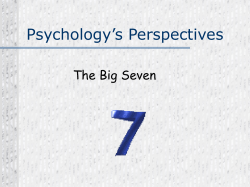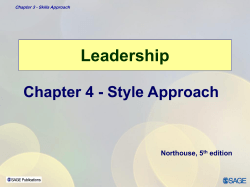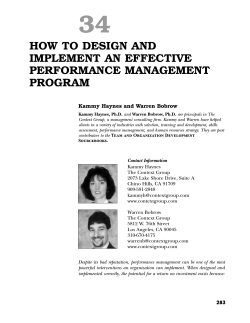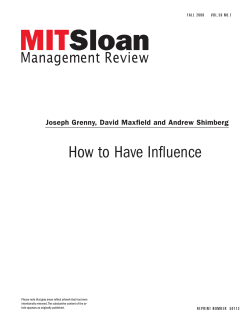
Manage the Culture Cycle By James L. Heskett
Insights Finance Regulation World Americas Africa Asia/China Europe Middle East Manage the Culture Cycle By James L. Heskett Organizational culture - the shared assumptions, values, and behaviors that determine “how we do things around here” really matters. L ou Gerstner in reflecting on his experiences in taking over the job of CEO at a failing IBM, said: “Until I came to IBM, I probably would have told you that culture was just one among several important elements in any organization’s makeup and success—along with vision, strategy, marketing, financials, and the like … I came to see, in my time at IBM, that culture isn’t just one aspect of the game—it is the game.1 Gerstner employed this philosophy in one of the largest corporate turnarounds in U.S. business history. Nucor Steel, the mini-mill operator, has achieved more than 160 consecutive quarters of dividends and the highest return to shareholders of any company in the Standard & Poor’s 500 between 2004 and 2009, due in large part to the successful application of technology resulting from innovative ideas generated by both employees and customers. Ken Iverson, who led the company until 2002 and still serves as an inspiration to the organization, attributes 30% of the company’s success to technology and industryleading innovation. What about the other 70%? He attributes that to culture.2 In the face of examples like these, how do we explain why there is so much circumstantial evidence that leaders are failing miserably in attending to the task of shaping and maintaining their organizations’ cultures? Why, for example, did a recent Conference Board sur- vey find that only 45% of U.S. workers were satisfied with their jobs, the lowest level in the 23-year history of the survey, at a time when many probably felt they were fortunate to have a job? Why is the phenomenon global? A 2005 Towers Perrin study of 86,000 full-time employees in 16 countries found that only 14% of respondents answered questions suggesting that they were “highly engaged” with their work as opposed to 25% who were identified as “disengaged.” The importance of this is underlined by the finding that those “highly engaged” indicated that they were more than twice as likely to stay in their jobs as those “disengaged.” Further, the report concluded that “companies with higher levels of employee engagement tend to outperform those with lower employee engagement.”3 Why, after giving lip service to the importance of an organization’s culture, do so many leaders walk away from the task of shaping it, preferring instead to concentrate on the de- Organization culture is based on four important sources of competitive advantage—the “Four Rs”—of referrals and retention of employees, returns to labor, and relationships with customers that foster customer referrals and retention. 2 The World Financial Review velopment of new strategies, systems, products, acquisitions, and facilities? Is there, for example, a misunderstanding of how much culture matters? These questions suggest a need for ways of estimating the economic advantages of an effective culture. Economic advantages of an effective culture: The “Four Rs” Organization culture is an abstract concept. No one argues against the value of an effective culture. But there is little hard evidence around which to rally support for efforts to create one. There are, however, clues which, when combined with a few assumptions, can provide a convincing case for the economic value of an effective culture. It [organization culture] is based on four important sources of competitive advantage—the “Four Rs”—of referrals and retention of employees, returns to labor, and relationships with customers that foster customer referrals and retention. Let’s start with the assumptions and work backward with pieces of evidence. Based on other research, some of which I have been associated with, over the years, I assume that organizations with effective cultures have the following advantages over their counterparts in which culture is neglected: 1. They benefit from higher job satisfaction and employee “ownership” behaviors (such as help in recruiting potential employees and providing suggestions for better, innovative ways of doing things). 2. Their recruiting, hiring, and training costs are reduced because of: (1) a higher proportion of hires from the pool of people referred by current or former employees and (2) higher retention rates. 3. Their employee retention rates are higher because of both (1) careful hiring practices that seek employees who subscribe to the organization’s values and (2) “self-selection” into the organization of people already attracted to the organization by its employees and their shared values. 4. Their wage levels are not inflated by many new hires from outside the organization. Hiring from the outside tends to inflate wage scales for everyone, particularly at higher levels of management. In fact, some employees may decide to accept lower wages in order to work in organizations with effective cultures. 5. As a result, they benefit from higher productivity per dollar of compensation, or as economists would put it, returns to labor. 6. Higher employee continuity leads to better relationships with customers which in turn produces higher sales levels as well as: (1) better retention rates for customers and fewer customers that have to be replaced to sustain sales levels and (2) a higher proportion of customers obtained through customer word-of-mouth referrals, resulting in lower marketing costs. It’s important to note several things about these “assumptions.” First, all of them are based on the findings of multiple studies. Second, their benefits are not mutually exclusive. That is, some amount of double counting may result in calculating them, although I’ve tried to minimize it in the example that follows. Third, the assumptions have differing levels of importance for various organizations. They are the most important in labor-intensive businesses in which organizations have many front-line managers and a large proportion of employees interacting frequently with customers. Thus, the assumptions are particularly relevant for retailers as well as providers of professional, business, and consumer services making up as many as 70% of the jobs in a typical developed economy. They apply also to government agencies such as the Ministry of Justice in the U.K. and the Internal Revenue Service in the U.S., agencies offering “customer services.” Here the benefits are primarily associated with creating better, more interesting jobs and places to work as well as the satisfaction that results from more positive interactions with satisfied “customers” (citizens). Taking the Four R’s into the real world Testing the Four R’s in the real world required access to data that I discovered didn’t exist in the few organizations I sampled. It’s an important clue to why culture is so difficult to track, shape, and maintain. It may help explain why there is much more talk than follow through among leaders in shaping their organizations’ cultures. Of the 34 pieces of information needed to carry out an analysis of the Four Rs in an organization, an informal survey of human resource managers in several companies showed that I could count on getting easy access to only 11. For two other measures, I found that “others have the data; it’s easy to get.” Ten others were available, but “it’s dif- 4 The World Financial Review Organizations with effective cultures benefit from higher employee continuity, which leads to better relationships with customers and higher sales levels. ficult to get.” And for 12 measures, the response I generally received was “I don’t think the data exists.” Fortunately, I was able to gain extraordinary access to an organization that I’ll call RTL, Inc., the subsidiary of a very large global firm offering a range of marketing services in a number of countries. Here was my “deal” with RTL’s leadership: They agreed to provide me with data for 2009 and 2010 from three U.S. offices of their choice. (Where data didn’t exist, management provided estimates.) The offices for which data were provided were to have very different levels of performance in these years. Performance levels were not to be shared with me until I had computed the effect of culture on performance based on an appraisal of the Four Rs—referrals, retention, returns to labor, and relationships with clients. In exchange, I agreed to: (1) identify the better performing office in each pair of offices for each year and (2) provide a “blind estimate” of how much of the difference in performance between the three offices was due to culture-related factors. The offices selected were located in Chicago, Baltimore, and Minneapolis (disguised locations). Applying the assumptions shown in Table A to the data, I calculated the differences due to culture-related matters that I would expect in operating profit for each pair of offices without knowing the actual performance for each office. The results are presented in Table B. They show that predictions tracked actual performance closely. When compared with actual numbers for both years, the blind estimates were directionally the same as the actual results. Table A Assumptions Used in Analyzing Data Provided for Three Offices of RTL Inc. to Estimate the Impact of Organization Culture on Operating Income for 2009 and 2010 1. Turnover costs as % of annual compensation for people replaced = 100% for voluntary departures and 50% for involuntary departures. 2. Portion of cost of involuntary departures attributed to culture = 50%. 3. Discount for costs of recruiting and training for new employees referred by existing employees = 25% of the cost of new recruits. 4. Improved returns to labor due to culture = 25% of the differential in labor costs/revenue. 5. Estimated revenue loss per lost client due to culture, as % of annual revenue = 50%. 6. Estimated operating margin on revenue associated with lost clients = 30%. 7. Cost per new client = one employee year of compensation. These are admittedly crude estimates, but the Four R analysis, judging from the results summarized in Table B, tells us that culture accounted for about half of the differences in operating income as a percentage of revenues for both years. Clearly, culture has a relatively high impact on operating income at RTL. This is the kind of business in which referrals, retention, returns to labor and relationships with customers are of paramount importance. They are not just the core of the business, they are the business. Table B Comparison of Blind Estimates of Differences In Actual Performance Due to Culture, Three RTL Offices, 2009 and 2010, in Percentage Points of Operating Profit to Revenue 2009 2010 Blind Estimate Actual Chicago vs. Baltimore* + 8.4 + 18.9 Chicago vs. Minneapolis - 1.5 - 3.5 Minneapolis vs. Baltimore + 9.9 + 22.4 Chicago vs. Baltimore + .5 + 1.6 Chicago vs. Minneapolis - 8.4 - 14.7 Minneapolis vs. Baltimore + 8.9 + 16.3 *This should be read as follows: Chicago was estimated to have an 8.4 percentage point advantage in operating profit as a percentage of revenue over Baltimore due to differences in culture in 2009; the actual differential from all sources was 18.9 percentage points. Several caveats In making the assumptions and presenting the analyses shown here, I run the risk of criticism from several directions. This is a simplified example. Some, I trust not too many, may regard it as simplistic. Others will criticize the impression of precision in the calculations. It’s a valid criticism. The estimates are directionally correct, but not even to tenths of a percentage point. But perhaps the most significant criticism will concern the importance attached to culture in each of the calculations. For example, a substantial portion of the economic impact of higher productivity is attributed to culture, something that accounts for more than 30% of the total benefits in the calculations. This may give too little weight to such things as superior technology, a different mix of product, or better processes. But the argument is complicated even further by my conviction that in an organization with a learning culture, superior processes and even superior technology often result from greater employee and customer “ownership” behaviors (leading to suggestions for better ways of doing things), a direct result of culture. And remember the response to my informal survey that concluded that culture was a much more significant contributor to performance than I’ve assumed here. The analysis suggests a set of measures with which an organization’s leadership can track the effectiveness of its culture: 1. Employee loyalty 2. Recruitment of new employees through referrals 3. Revenue per unit of compensation (labor cost productivity) 4. Customer loyalty 5. Referrals of new customers by existing ones When combined with others, such as the rate and results of innovation, they provide powerful explanations—in fact, predictors—of profit and growth. The path to achieving these goals is described by what I call the culture cycle shown in Figure 1. The “stations” of the cycle provide a map of the path toward outstanding performance on predictors of long-term financial performance. They are derived from a study of dozens of in-depth cases that I, and others, have written, and are reflected in detailed data from a comprehensive employee engagement survey conducted by RTL in 2010. Leadership in the culture cycle A. G. Lafley, former CEO of Procter & Gamble, maintains that “shaping September - October 2011 values and standards” is one of four tasks that only a CEO can do. The marching orders for success in shaping values are shown in the outer circle in Figure 1. Station One: First, the starting point in the cycle comprises an inspiring mission as well as elements of culture, such as assumptions about why people contribute to the work of an organization, the values shared by employees, and behaviors exhibited by managers and others. Does everyone in the organization, including new recruits, understand what these are? Are they universally accepted? Station Two: Next, the statements of mission and culture contain implied promises to those employed by the organization. The promises concern things that employees tell us are of greatest importance to them: the quality and fairness of my boss, my opportunity for personal development, the quality of the feedback I receive, the quality of my colleagues, the amount of latitude I have (within limits) to deliver results to the people who count on me, and (often far down the list) reasonable compensation. Does leadership understand what employees are seeking? Does it understand what kinds of promises are valued most highly as part of the employment “deal”? Station Three: Is the “deal” being kept, thereby producing the kind of trust and loyalty important to success? What is leadership doing to make sure that expectations, once set, are met? Are expected behaviors reflected in the actual behaviors of those in charge? What happens to those whose behaviors don’t reflect shared values and behaviors and confirm the promises? Station Four: The importance of whether or not “the deal” is met is reflected in the levels of trust, engagement, and “ownership” that result from promises or expectations that are generally fulfilled on a day-to-day basis on the job. Trust leads to engagement, the willingness of employees to recommend their organization to others as a place to work, for example. Engagement in turn leads to “ownership,” a level of commitment that inspires employees to actually recruit new candidates and recommend new ways of doing things. Employee engagement and ownership leads to similar behaviors on the part of customers4. High levels of trust, engagement, and ownership facilitate the implementation of policies, practices, and suggested behaviors that comprise Station Five. Station Five: Policies, practices, and behaviors that contribute to effective cultures include such things as self-direction, accountability, transparency, informed risk-taking, collaboration, inclusion, putting one’s organization above oneself, and boundarylessness—whatever is considered critical in executing the organization’s strategy. Station Six: Policies, practices, and behaviors contribute in turn to the kind of inquiry, best practice analyses, and benchmarking as well as the speed and adaptability that characterize a learning, innovative, agile organization. Station Seven: The foregoing stations of the culture cycle contribute to an organization that performs well or poorly on measures of the Four Rs, innovation, and ultimately financial performance. Station Eight: Finally, if gaps are appearing between desired and actual performance, especially on the Four Rs, is a review of culture called for? Does value have to be reaffirmed? Are behaviors out of line? Can it be corrected with changes as subtle as “just doing it,” www.worldfinancialreview.com 5 Figure 1 The Role of Leadership in the Culture Cycle Perceive the need for change in mission and values Track non-financial as well as financial results Be patient for long-term results, impatient for early wins Measure and reward Sort out organizational learning (continuous “believers” from “non-believers” improvement) Review need for change (measure gaps) Identify and establish priorities for conditions and behaviors that meet the organization’s needs to execute its strategy (such as self-determination and latitude, accountability, transparency, informed risk-taking, collaboration, clustering, inclusion, organization above self, boundary lessness) Propose changes “from the top” Create new statements of values and behaviors acting out desired behaviors? Or does it require that a more basic appraisal involving the entire organization is needed? Detecting the need to reshape the culture An organization that waits for a significant downturn in financial measures such as growth and profit to signal the need for change is doomed to fail. The telltale signs that a dysfunctional culture is developing are many. They may include a poor sense of mission, often resulting from the hiring of people with the wrong motives, such as those seeking largely extrinsic rewards (high pay) that run counter to the intended mission. Other signs include constant planning and re-planning, with a chronic inability to meet plans. This suggests the inability to identify a coherent, realistic strategy with sufficient long-run potential to enable an organization to meet its goals. It is often accompanied by frequent reorganization and turnover in leadership positions with too many external hires, an increase in the politicization of the organization with an attendant rise in bureaucracy, increasing numbers of levels of management, the frequency of “studies” as a means of deferring decisions, too much time 6 The World Financial Review Insure that employee expectations are established that can be met Establish dissatisfaction with status quo Select “chance talent” Demonstrate new behaviors (just do it) Communicate Communicate Insure alignment between culture, strategy, and method of execution Conduct organizationwide referendum Encourage and recognize behaviors that meet employee expectations for the job, leadership, personal development, quality of talent, latitude to deliver results, and compensation Measure and track trust, engagement and ownership An organization that waits for a significant downturn in financial measures such as growth and profit to signal the need for change is doomed to fail. spent in committees, managers supervising other managers, and the inability to make timely decisions. Various combinations of these maladies will appear as declining levels of trust, engagement, ownership behaviors (such as referrals), and loyalty among employees; slowing productivity and innovation; and lower levels of customer loyalty and ownership. The warnings provide the basis for early action. Again, the culture cycle can be instructive in suggesting the kinds of action that are needed. Leading culture change Leading culture change is not the focus of this article. But experiences in dozens of organizations that I’ve had an opportunity to document suggest several important pointers that are diagrammed as the inner “change loop” of the culture cycle in Figure 1. They include: (1) reviewing the need for change, using the kinds of data described above, (2) where it does not exist already, establishing a dissatisfaction in the organization with the status quo, (3) selecting “change agents” to participate in drafting and communicating proposed changes, (4) preparing proposed changes in mission, shared assumptions and values, and behaviors, (5) conducting an organization-wide referendum on the proposed changes, (6) finalizing the revisions, (7) over-communicating every step of the way, (8) personally demonstrating the new behaviors, (9) sorting out the “non-believers” in a timely way, and (10) combining patience for long-term results with an impatience for early wins to validate the effort in the eyes of members of the organization. Having said this, it is important to remember that these aren’t necessarily sequential. Some can be “fast-tracked” simultaneously. Nor is this set of steps meant to portray all change efforts. Each is adapted to the particular needs (and existing culture) of the organization in which it is being applied. Why are our cultures failing us? I began by asking why job satisfaction has fallen to new lows in the U.S., reflecting similar levels in the rest of the world. Explanations lie in both how senior managers carry out their jobs and in the fallout experienced by employees making an effort to negotiate their respective cultures. Obviously, culture is not the only culprit. But it [culture] affects how a job “feels”—how enthusiastically we go to work and with how much loyalty to the organization--more than any other phenomenon. Anything that explains up to half of the difference in operating performance between two organizations has to be a high priority for leadership. But why doesn’t it receive the attention it demands? There are four primary reasons. First, far too many senior managers talk a much better game than they deliver when it comes to shaping or reshaping cultures. It’s fashionable. If it is only talk, better not to make the effort. Cultures will shape themselves without leadership, for better or worse. If ignored, they constitute just one more unknown in the task of executing a strategy. Second, changing a culture, if it involves a reexamination of the shared assumptions and values that influence “how we do things around here,” probably requires more lapsed time than most CEOs have remaining in their tenure. As a result, it is a task that may span the administrations of two CEOs who may not share the same priorities. But the amount of time required to reshape a culture may, in many instances, be overestimated. There is a hierarchy of elements of a culture ranging from shared assumptions and values (least visible, hardest to flush out and change) to behaviors and artifacts (most visible and easiest to change). In many cases, useful change in culture can be achieved in relatively short periods of time if the focus is on a change in behaviors that reflect shared values that may already be in existence. In this instance, the advice to senior managers is to “just do it.” For example, Lou Gerstner sent powerful messages to his organization by attending meetings that his predecessor had not made it a point to attend and by listening intently to what others were saying in those meetings. If you are consistent in your new patterns of behavior, others will pick them up quickly. Third, culture is shaped and tracked by the numbers—just not financial numbers. And in too many cases, the numbers simply don’t exist. Running an organization only on the financial numbers is like driving with the rear view mirror. The Four Rs of retention, referrals, returns to labor, and relations with customers will have declined long before the financial results begin to show it. By then it will be far too late to effect changes in culture necessary to turn performance around. Fourth, too little attention has been devoted to the basics of the culture cycle that involve an understanding that: (1) the foundation of an inspiring mission as well as commonly-shared assumptions and values accompanied by accepted behaviors is absolutely essential to an effective culture, (2) they provide the basis on which expectations are set for current and prospective members of the organization, (3) no expectations should be set that can’t be met; better to create fewer expectations and meet them all, (4) expectations, consistently met, provide the basis for core phenomena of employee trust, engagement, and “ownership,” (5) without the core phenomena, it will be very difficult to implement desired policies, September - October 2011 practices, and behaviors such as accountability, self-direction, teamwork, and the like, (6) it’s the policies, practices, and behaviors such as boundarylessness and cross-function teamwork that create the potential for a learning, agile organization that can deliver on the Four Rs—retention, referrals, returns to labor, relationships with customers—over long periods of time. ness of the ways in which it matters, as well as ways of insuring that it matters for the better, will lead to the kinds of choices that produce a better bottom line and, even more important, a better world in which all of us can live and work. This article is based on material from the book, The Culture Cycle: Shaping the Unseen Force That Will Transform Performance, by James Heskett, FT Press 2011. About the author Perhaps the biggest headline should be reserved for unmet expectations. Today’s entrants into the work force expect jobs where the boss is fair, the feedback is frequent, the opportunities for personal development are high, people are recognized for their accomplishments, the quality of the work team is beyond question, latitude is provided (within limits) to deliver results to others, and the compensation is reasonable. When these conditions are met or exceeded, both intrinsic rewards and economic performance can be remarkable. But clearly they are being met all too infrequently. What’s the answer? If job satisfaction is to be revived in this world, either job entrants and employees have to adjust their expectations downward, employers have to seek ways of meeting them, or both things have to happen. Let’s hope that the answer is the development of cultures that foster behaviors that meet expectations. An examination of why and how culture matters is an inexact science. It’s too complex to sort out completely. But an aware- James Heskett is Baker Foundation Professor Emeritus at the Harvard Business School where he joined the faculty in 1965. While at Harvard, Heskett taught courses in marketing, business logistics, service management, general management, and entrepreneurial management and, at one time, served as chair of all academic programs. He completed his MBA and PhD degrees at Stanford University and also taught at The Ohio State University. Heskett has served as President of Logistics Systems, Inc. and on the boards of more than a dozen corporations and not-for-profit organizations. In addition, he has consulted for companies in the United States, Europe, Asia, and Latin America. Heskett is currently a director of Limited Brands, Inc. Among his writings are articles in the Harvard Business Review and Sloan Review of Management. Heskett has also coauthored several books, including Service Breakthroughs, The Service Profit Chain, The Ownership Quotient, and Corporate Culture and Performance. His most recent book is The Culture Cycle: How to Shape the Unseen Force that Transforms Performance, published by FT Press in 2011. Notes 1. Louis V. Gerstner, Jr., Who Says Elephants Can’t Dance?: Inside IBM’s Historic Turnaround (New York: HarperCollins, 2002), pp. 181-182. 2. nucorsteel.com website, May 2010. Unless otherwise noted, the quotes in this section are drawn from the website. 3. Ibid., p. 30. 4. See James L. Heskett, W. Earl Sasser, and Joe Wheeler, The Ownership Quotient: Putting the Service Profit Chain to Work for Unbeatable Competitive Advantage (Boston: Harvard Business Press, 2008). www.worldfinancialreview.com 7
© Copyright 2025





















